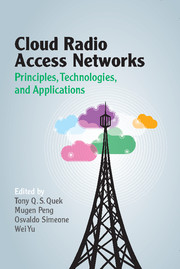Book contents
- Frontmatter
- Contents
- Acknowledgments
- Foreword
- Preface
- List of Contributors
- Part I Architecture of C-RANs
- Part II Physical-Layer Design in C-RANs
- Part III Resource Allocation and Networking in C-RANs
- Part IV Networking in C-RANs
- 16 Mobility Management for C-RANs
- 17 Caching in C-RAN
- 18 A Cloud Service Model and Architecture for Small-Cell RANs
- 19 Field Trials and Testbed Design for C-RAN
- Index
- References
16 - Mobility Management for C-RANs
from Part IV - Networking in C-RANs
Published online by Cambridge University Press: 23 February 2017
- Frontmatter
- Contents
- Acknowledgments
- Foreword
- Preface
- List of Contributors
- Part I Architecture of C-RANs
- Part II Physical-Layer Design in C-RANs
- Part III Resource Allocation and Networking in C-RANs
- Part IV Networking in C-RANs
- 16 Mobility Management for C-RANs
- 17 Caching in C-RAN
- 18 A Cloud Service Model and Architecture for Small-Cell RANs
- 19 Field Trials and Testbed Design for C-RAN
- Index
- References
Summary
Introduction
Cloud-RAN is a promising wireless network architecture in 5G networks, and it was first proposed by the China Mobile Research Institute [1]. In C-RANs, baseband processing is centralized in a baseband unit (BBU) pool, while radio frequency (RF) processing is distributed in remote radio heads (RRHs). The C-RAN network architecture can reduce both the capital expenditure (CAPEX) and operating expenditure (OPEX) for mobile operators, because fewer BBUs are potentially required in the C-RAN architecture, and the consumed power is lowered [2].
Heterogeneous small-cell networks have attracted much attention owing to the explosion in demand of users' data requirements. In heterogeneous small-cell network, low-power small cells (such as pico-cells, relay cells and femto-cells), together with macro cells, can improve the coverage and capacity of cell-edge users and hotspots by exploiting the spatial reuse of spectrum [3]. Small cells can also offload the explosive growth of wireless data traffic from macro cells. For example, in an indoor environment WiFi and femtocells can offload most data traffic from macro cells [4]. For mobile operators, small cells such as femtocells can reduce the CAPEX and OPEX because of the self-installing and self-operating features of femto base stations.
The combination of a heterogeneous small-cell network and a C-RAN, which is called a heterogeneous cloud small-cell network (HCSNet), benefits from employing both C-RAN and a small-cell network [5]. First, C-RAN reduces the power and energy cost in HCSNet by lowering the number of BBUs in densely deployed heterogeneous small-cell networks. Second, BBUs can be added and upgraded without much effort in the BBU pool, and network maintenance and operation can also be performed easily. Third, many radio resource management functions can be facilitated in the BBU pool with little delay. In HCSNet, cloud-computing-enabled signal processing can be fully utilized to mitigate interference and to improve spectrum efficiency in 5G networks.
In the literature, HCSNet has been studied extensively. In [5], state-of-the-art research results and challenges were surveyed for heterogeneous C-RANs, and promising key techniques were investigated to improve both spectral and energy efficiencies. To mitigate the interference for cell-edge users, coordinated multi-point (CoMP) transmission and reception is also investigated in a C-RAN environment. The C-RAN network architecture is effective for implementing CoMP. Energy-efficient resource optimization was studied in [7] for C-RAN-enabled heterogeneous cellular networks.
Information
- Type
- Chapter
- Information
- Cloud Radio Access NetworksPrinciples, Technologies, and Applications, pp. 397 - 406Publisher: Cambridge University PressPrint publication year: 2017
